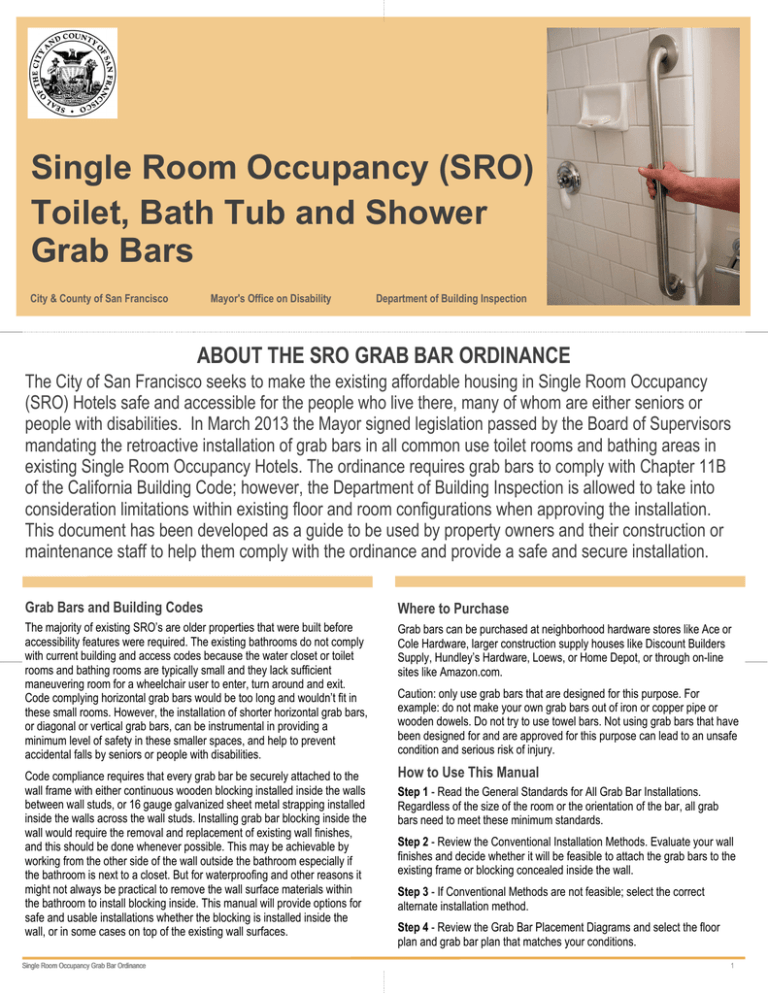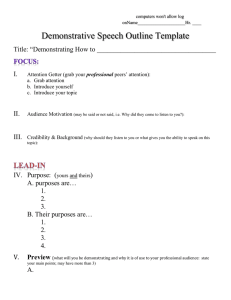SRO Grab Bar Installation Manual
advertisement

Single Room Occupancy (SRO) Toilet, Bath Tub and Shower Grab Bars City & County of San Francisco Mayor's Office on Disability Department of Building Inspection ABOUT THE SRO GRAB BAR ORDINANCE The City of San Francisco seeks to make the existing affordable housing in Single Room Occupancy (SRO) Hotels safe and accessible for the people who live there, many of whom are either seniors or people with disabilities. In March 2013 the Mayor signed legislation passed by the Board of Supervisors mandating the retroactive installation of grab bars in all common use toilet rooms and bathing areas in existing Single Room Occupancy Hotels. The ordinance requires grab bars to comply with Chapter 11B of the California Building Code; however, the Department of Building Inspection is allowed to take into consideration limitations within existing floor and room configurations when approving the installation. This document has been developed as a guide to be used by property owners and their construction or maintenance staff to help them comply with the ordinance and provide a safe and secure installation. Grab Bars and Building Codes Where to Purchase The majority of existing SRO’s are older properties that were built before accessibility features were required. The existing bathrooms do not comply with current building and access codes because the water closet or toilet rooms and bathing rooms are typically small and they lack sufficient maneuvering room for a wheelchair user to enter, turn around and exit. Code complying horizontal grab bars would be too long and wouldn’t fit in these small rooms. However, the installation of shorter horizontal grab bars, or diagonal or vertical grab bars, can be instrumental in providing a minimum level of safety in these smaller spaces, and help to prevent accidental falls by seniors or people with disabilities. Grab bars can be purchased at neighborhood hardware stores like Ace or Cole Hardware, larger construction supply houses like Discount Builders Supply, Hundley’s Hardware, Loews, or Home Depot, or through on-line sites like Amazon.com. Code compliance requires that every grab bar be securely attached to the wall frame with either continuous wooden blocking installed inside the walls between wall studs, or 16 gauge galvanized sheet metal strapping installed inside the walls across the wall studs. Installing grab bar blocking inside the wall would require the removal and replacement of existing wall finishes, and this should be done whenever possible. This may be achievable by working from the other side of the wall outside the bathroom especially if the bathroom is next to a closet. But for waterproofing and other reasons it might not always be practical to remove the wall surface materials within the bathroom to install blocking inside. This manual will provide options for safe and usable installations whether the blocking is installed inside the wall, or in some cases on top of the existing wall surfaces. How to Use This Manual Single Room Occupancy Grab Bar Ordinance Caution: only use grab bars that are designed for this purpose. For example: do not make your own grab bars out of iron or copper pipe or wooden dowels. Do not try to use towel bars. Not using grab bars that have been designed for and are approved for this purpose can lead to an unsafe condition and serious risk of injury. Step 1 - Read the General Standards for All Grab Bar Installations. Regardless of the size of the room or the orientation of the bar, all grab bars need to meet these minimum standards. Step 2 - Review the Conventional Installation Methods. Evaluate your wall finishes and decide whether it will be feasible to attach the grab bars to the existing frame or blocking concealed inside the wall. Step 3 - If Conventional Methods are not feasible; select the correct alternate installation method. Step 4 - Review the Grab Bar Placement Diagrams and select the floor plan and grab bar plan that matches your conditions. 1 General Standards for all Grab Bars DIAGRAM 2 BLOCKING OR BACKING SUPPORT Follow manufacturer’s installation instructions. Grab bars need to be securely attached so the bar can withstand a 250 lb load without pulling out of the wall. Grab bars shall be vertical, diagonal, or horizontal, depending on space constraints and location. The minimum grab bar length shall be 18” for a vertical bar, or 24” for a horizontal bar. When space allows, use longer grab bars that are 36”, 42”, or 48” in length. Grab bar diameter shall be a minimum of 1 ¼” and a maximum of 1 ½”. LAYOUT AND FASTENING The clearance behind a grab bar shall be 1 ½” exactly for a safe grip. Alternate Installation Method The clearance below a grab bar to a fixture, such as a toilet paper dispenser etc., shall be 1 1/2" minimum. If it is Not Possible to Remove and Replace Wall Finishes When it is not feasible to remove existing wall surfaces, the grab bar may be attached to surface mounted materials so long as they meet the minimum standards below. There shall be no sharp edges on the grab bar surface or on the mounting plates. This includes screws, bolts, or fasteners which must be counter sunk (flush below the surface) or have smooth and rounded screw heads. Stainless steel fasteners (screws) are recommended. They are strong and won’t rust. Fasteners (screws) need to be long enough so they penetrate 1 ¼” into the frame. A 2” screw is usually long enough after going through 5/8” of plaster or sheet rock. Use longer screws when going through tile over mortar and plaster or sheet rock. In water closet or toilet rooms, the grab bar may be attached to a surface mounted 2” x 6” piece of lumber that has been securely fastened to the wall frame. Securely fastened means using a minimum of two screws per stud, a minimum of six screws per board, using a board that is at least six inches longer than the grab bar on each end, and a board that is long enough to extend past the end of the grab bar to catch an attachment to the next stud. See diagram 2. DIAGRAM 3 SURFACE MOUNTED SUPPORT DIAGRAM 1 GRAB BAR DETAIL ALTERNATE INSTALLATION METHOD SURFACE MOUNTED SUPPORT Conventional Installation Methods If it is Possible to Remove and Replace Wall Finishes Conventional installation shall be used whenever feasibly possible. This may require the removal and replacement of existing wall surfaces in order to ensure adequate framing support. See next section below for alternate methods if it is not feasible to remove wall finishes. Vertical and diagonal grab bars can usually be installed directly to existing stud frame, which is typically 16” on center, without requiring the removal of wall finishes. At least two screws per grab bar mounting plate must attach firmly to 2” x 4” stud frame. The third screw can be a heavy duty hollow wall anchor such as a toggle bolt. Horizontal grab bars must be installed to solid 2” x 6” blocking or six inch wide 16 gauge galvanized sheet metal installed horizontally inside the wall cavity. The horizontal grab bar itself is installed between 33” and 36" above the floor. See diagram 2. For concrete (typically exterior) walls the bar has to be attached with approved fasteners such as tapcons, which is a trademarked name for a special concrete screw. Use caulking to seal any holes made in tub or shower areas to prevent water from damaging the building. Single Room Occupancy Grab Bar Ordinance When using wood for surface mounting in water closet or toilet rooms, the wood needs to have rounded or chamfered edges, be pre-primed on both sides and all edges, and be painted with a durable, easily cleaned finish coat, typically gloss paint finish. Use screws that are at least 3” long to attach the lumber to the stud frame, and counter sink the heads below the surface as needed to reduce sharp edges and to get at least 1 ¼” penetration into the underlying stud frame. In water closet, toilet rooms, or tub and shower areas, the grab bar may alternatively be attached to 16 gauge stainless steel sheet metal straps that are at least 6” wide. Use a minimum of two screws per stud, a minimum of six screws per strap, a strap that is at least six inches longer than the grab bar on each end, and that is long enough to extend past the end of the grab bar to catch an attachment to the next stud. See diagram 2. Since stainless steel sheet metal can have sharp edges, the surface mounted strap must be fully covered with corian, or other durable sanitary synthetic materials that will not be affected by water. Wood cannot be used in tub or shower areas. It is important to note that while the mounting screw goes through the cover material, the grab bar attachment is to the sheet metal. Both the cover material and the wall surface or tile behind the grab bar and sheet metal will need to be pre-drilled. Use caulking to seal any holes made in tub or shower areas and to seal around any surface mounted materials to prevent water from damaging the building. 2 GRAB BAR PLACEMENT IN WATER CLOSET OR TOILET ROOMS DIAGRAM 4 CODE COMPLYING LARGE TOILET ROOMS Side grab bar is 42” minimum in length Grab bar at rear is 36” minimum in length Installation height is between 33” and 36” measured on center DIAGRAM 5 ALTERNATE NARROW OR SMALL TOILET ROOM A narrow or small toilet room should have two grab bars, one on each side. The side grab bar is a minimum of 24” in length but should be as long as possible, not to exceed 42”. The horizontal side grab bar is installed between 33” and 36” above the floor. See 1.0 DIAGRAM 6 CODE COMPLYING BATH TUB A code complying bath tub has four grab bars. DIAGRAM 7 ALTERNATE BATH TUB An alternate bath tub has a minimum of two grab bars. One is placed vertically on the control wall at the outer edge where the framing is located. One bar is placed diagonally on the back wall. The diagonal bar should be angled so it can be securely attached to the existing stud frame that is 16” on center. Each grab bar is a minimum 24” long. A diagonal grab bar also works well. Position so the top of bar is no higher than 42” above the floor. The diagonal bar should be angled so it can be securely attached to the existing stud frame that is 16” on center. See 2.0 Single Room Occupancy Grab Bar Ordinance 3 GRAB BAR PLACEMENT IN WATER CLOSET OR TOILET ROOMS DIAGRAM 8 CODE COMPLYING ROLL IN SHOWER WITH SEAT DIAGRAM 10 ALTERNATE SMALL 36"x36" SHOWER An alternate shower stall has a minimum of two grab bars. One is placed vertically on the control wall at the outer edge where the framing is located. One bar is placed diagonally on the back wall. DIAGRAM 9 CODE COMPLYING 48"x42" TRANSFER SHOWER The diagonal bar should be angled so it can be securely attached to the existing stud frame that is 16” on center. Each grab bar is a minimum 24” long. TOOLS Drill, special drill bit for tile and glass, counter sink drill bit, stainless steel screw, approved (Toggle) hollow wall anchor (should only be used for one of the three fasteners per mounting bracket), caulk. DISCLAIMER The intent of this pamphlet is to assist property owners and their staff in complying with the SRO ordinance. The owner is advised to always follow the manufacturer’s instructions for installation. The examples used may not reflect the actual conditions found in your building. The City and County of San Francisco assumes no legal liability or responsibility for the accuracy, completeness, nor usefulness of any information, product, or process disclosed in these examples. Reference herein to any specific product, process, service by trade, name, trademark, manufacturer, or otherwise, is provided only as an example or illustration and does not constitute the City and County of San Francisco’s endorsement or recommendation. Owners should conduct an independent review and evaluation of products and services prior to use. Single Room Occupancy Grab Bar Ordinance 4


